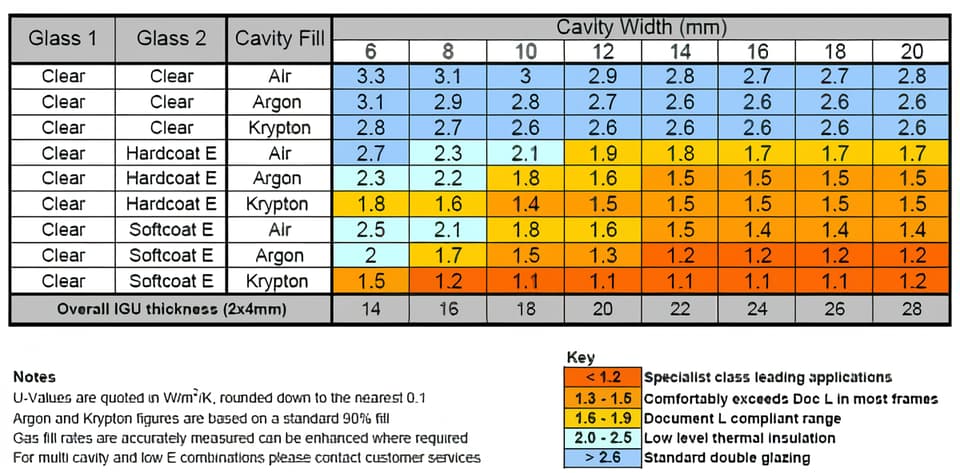Glass
Contact us
Table of Contents
Click or select the topic of interest.
- Low Modulus Neutral Cure Silicone
- Low Modulus
- Neutral Cure
- Double glazing or triple glazing
- Single glazing
- Toughened glass
- Why do we need toughened glass?
- Fire rated glass
- Laminated glass
- Noise reduction glass
- Low iron glass
- Low – “E” glass (soft and hard coat)
- Soft Coat Low-E Glass
- Hard Coat Low-E Glass
- Textured glass
- Satin Glass -Frosted Glass
- Etched Privacy Glass
- Smart glass or switchable glass
- Applied leads on double glazed units
- Self-cleaning glass
- Imperfections in glass
- Crown glass/Restoration glass
- Slim Double glazing
- Gas infills for double glazed units
- U-Value calculations with chart
Low Modulus Neutral Cure Silicone
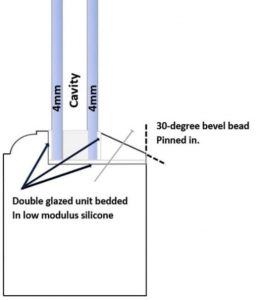
For the application of bedding in double-glazed units, it’s essential that you use a Low Modulus Neutral Cure These types of silicone provide excellent adhesion to both glass and timber surfaces, forming a strong bond and ensuring the double-glazed unit remains securely in place. Neutral curing silicones don’t harm double-glazed units, whilst providing excellent weather resistance including resistance to UV, moisture, and extreme temperatures.
What is Low Modulus?
High modulus silicone sealants are less flexible and more rigid. If a high modulus silicone is used in a situation where flexibility is required, such as accommodating the movement of the timber frame, it may exert excessive stress on the double-glazed unit and lead to glass breakage or seal failure.
What is Neutral Cure?
Double glazing or triple glazing
There are a couple of key disadvantages – it is more expensive, and it is heavier – this additional weight reduces the maximum sizes for the window or door. If you want to achieve a particular standard (like Passive House) then you may need to specify triple glazing, but if you just want something that will keep the house sensibly warm, then the reality is that a well specified double-glazed unit is more than adequate and in reality you might be hard pushed to notice the difference between this, and the triple glazed alternative.

Single glazing
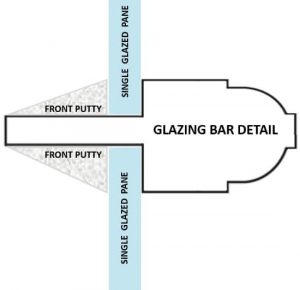
Toughened glass
Why do we need toughened glass?
Do you have any windows and doors in your home that you may come into contact with if you tripped and tried to use the glass to stop yourself falling? Then you might need toughened glass in those locations.
Standard glass, sometimes referred to as annealed or float glass, breaks into large, sharp pieces with jagged edges. This presents a serious risk of injury if you were to fall against it. To reduce this risk, we put the standard glass through a toughening process. This process changes the structure of the glass so that if it breaks it shatters into lots of small pieces. These small pieces are about the size of your fingernail and is better than a few large sharp pieces. You can see the comparison between toughened glass and standard, float glass, when they break below.
Therefore, it becomes much safer to use in doors, low windows, or frames next to doors. In the unlikely event that someone trips in one of these locations and their hands, arms or body come into contact with the glass then if it breaks, it will break safely. The toughened glass will shatter into lots of small pieces and is far less likely to cause any serious damage.
Toughened glass is also known as tempered glass and is a type of safety glass that is designed to be stronger and safer than regular glass. toughened glass is versatile and predominantly used in single and double pane windows and doors. It is made by flowing, soft glass being poured onto a bed on molten tin. The glass floats, spreads, and cools to form an even smooth surface of sheet glass. The toughening process is carried out after it has been processed.
https://www.pilkington.com/~/media/Pilkington/Site%20Content/UK/Reference/BRImpactSafetyPDF.ashx
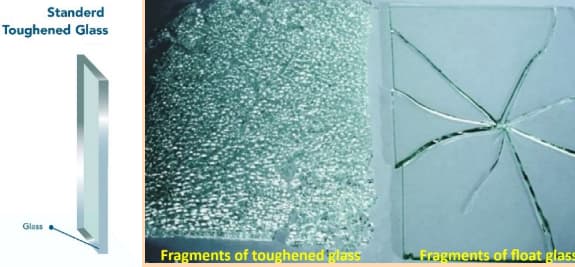
Fire rated glass
https://www.pilkington.com/en-gb/uk/products/product-categories/fire-protection
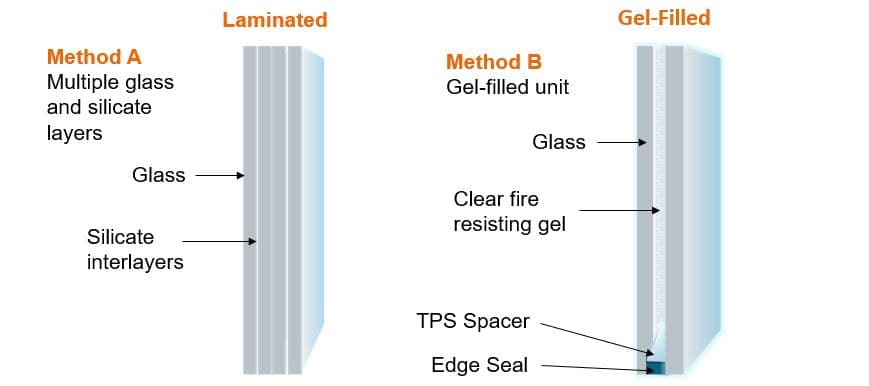
Laminated glass
Laminated glass comprises two sheets of glass sandwiched around a thin layer of (usually) polyvinyl butyral (PVB). This lamination process is done under heat and pressure, making the PVB act as a type of glue to stick the two sheets of glass together, creating one clear pane. Not only does laminated glass have a higher impact resistance, if one or both of the panes of glass do break, but the pieces of glass also remain stuck to the PVB interlayer. This makes the glass both safer and more secure. An intruder who is determined enough to keep hammering away at the glass will be able to make a hole in the PVB and may be able to get in eventually, but it will take a long time and all the hammering will create a lot of noise. Most intruders will give up when they realise the glass is laminated.
https://www.pilkington.com/en-gb/uk/products/product-categories/safety-security/pilkington-optilam

Noise reduction glass
Modern double glazing is generally very good at insulating against outside noise. However, if you live in a particularly noisy area you might want to consider the following options:
• Increasing the gap between the panes is a good way of reducing the noise. This is limited by the window or door system – some can have a thicker sealed unit than others.
• Making one of the panes of glass thicker (perhaps 10mm) is also effective at reducing the noise. This adds to the weight, reducing the maximum size of the window or door, and can mean the glass has a deeper tint than a thinner pane would. See the section on low iron glass below.
• There are now some very clever acoustic laminates available which offer some excellent results. They are designed to both reflect the noise away from the building and also to absorb the noise in the acoustic interlayer. A combination of these three measures will give some very good noise reduction benefits.
https://www.pilkington.com/en/global/products/product-categories/noise-control/pilkington-optiphon

Low iron glass
When you look at the cut edge of a standard pane of glass it is green. Most panes of glass are thin enough that you don’t really notice this green tint when looking out of the window. Low iron glass tends to be much clearer – if you look at low iron glass side-on you may still see a slight tint, but it is significantly less than on a standard pane. The clarity of low iron glass is useful in helping to maximise solar gain (the amount of energy that enters a room from the sun). This in turn is one of the measures used to classify a window or door’s thermal performance in the energy rating scheme
https://www.pilkington.com/en-gb/uk/products/product-categories/special-applications/pilkington-optiwhite

Low – “E” glass (soft and hard coat)

Soft Coat Low-E Glass
Soft Coat Low-E glass windows are the most energy-efficient window replacement option available. Soft Coat Low-E windows can prevent UV rays from transmitting through the glass at a 70% higher rate than a standard window. While Soft Coat Low-E glass is the most effective in maintaining energy efficiency it is also typically the more expensive and less durable compared to the Hard Coat option.
https://www.planitherm.com/
https://www.pilkington.com/en-gb/uk/products/product-categories/thermal-insulation/pilkington-k-glass-range/pilkington-k-glass-s
Hard Coat Low-E Glass
Hard Coat Low-E glass is a much more inexpensive and easier to care for option then Soft Coat Low-E. This glass is made with fewer layers of coating the Soft Coat Low-E glass and because of this, it is the far more durable option. Unlike windows made with Soft Coat Low-E glass, Hard Coated windows can be handled without gloves and will not suffer any damage from hanging blinds on them! While Hard-Coat Low-E glass is the less expensive option over time they will cost you more in energy bills as they are not as efficient in blocking sunlight or maintaining your home’s temperature. They are still a great option as they are much more energy-efficient then your standard window.
https://www.pilkington.com/en-gb/uk/products/product-categories/thermal-insulation/pilkington-k-glass-range/pilkington-k-glass
Textured glass
Textured glass may be used for privacy or for decorative purposes. There are a number of obscure glass options offering varying degrees of privacy that are most commonly used for front doors and bathrooms. Coloured films, lead patterns and bevelled glass designs are all available to add character to an otherwise plain piece of glass. Whilst these have been popular in the past for bay window fanlights and conservatories, they tend now to be used more just for front doors.
https://www.pilkington.com/en-gb/uk/products/product-categories/decoration/pilkington-texture-glass
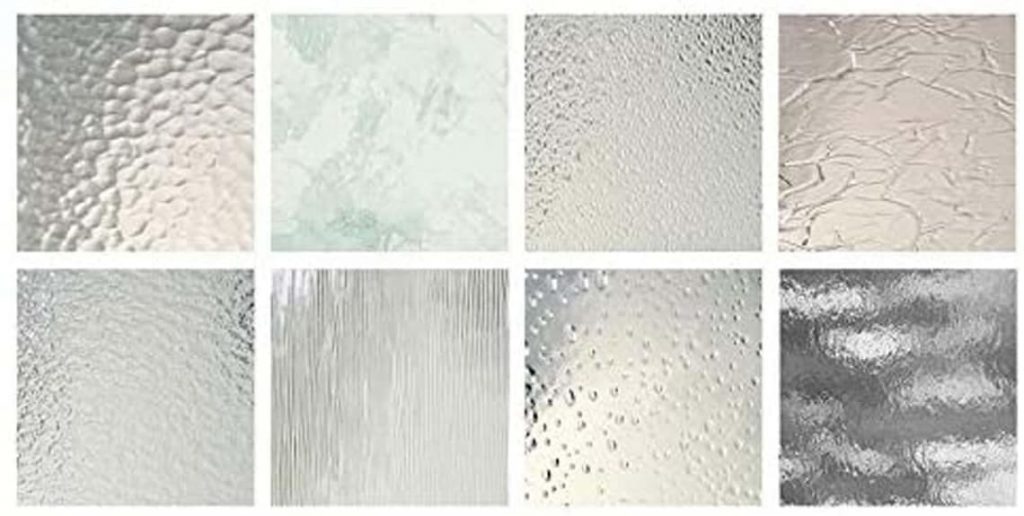
Satin Glass -Frosted Glass
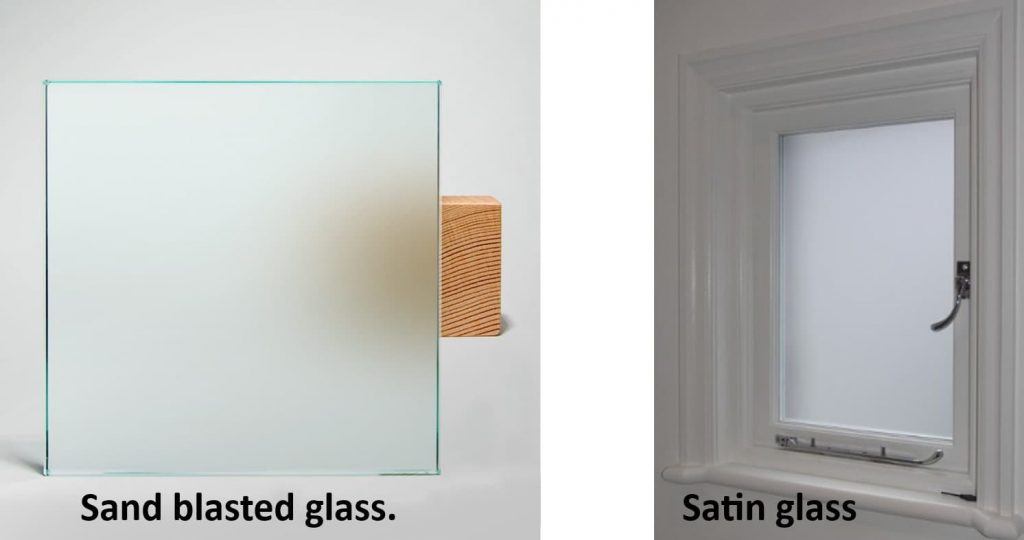
Etched Privacy Glass
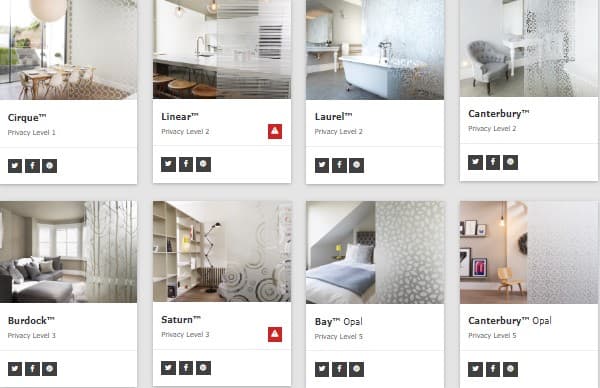
Smart glass or switchable glass
Smart glass or switchable glass is clever stuff. At the flick of a switch, the glass changes from being clear and transparent to being (usually fully) opaque. It is also possible to have smart glass that gradually becomes more or less tinted with changes to the electric current.
There are few alternative technologies available to achieve this, but they tend to work in a similar way – the glass is opaque or tinted and then when a small electric current is passed through the glass it becomes clear. The glass is perfectly safe to touch and certainly has a wow-factor, but it is expensive to buy, and it needs a power source. For a new build or an extension, getting power to the windows and doors is not generally a problem, but for the replacement windows and doors market it would mean a lot of redecorating.
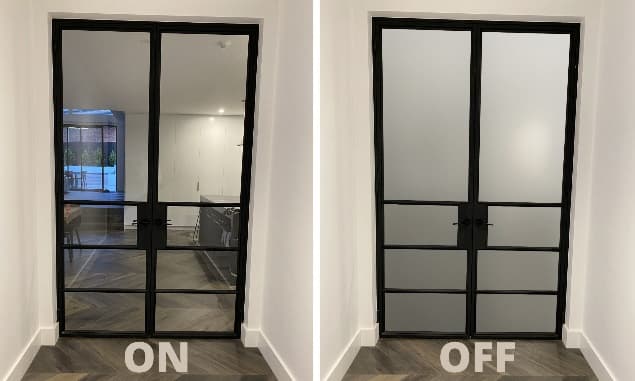
Applied leads on double glazed units
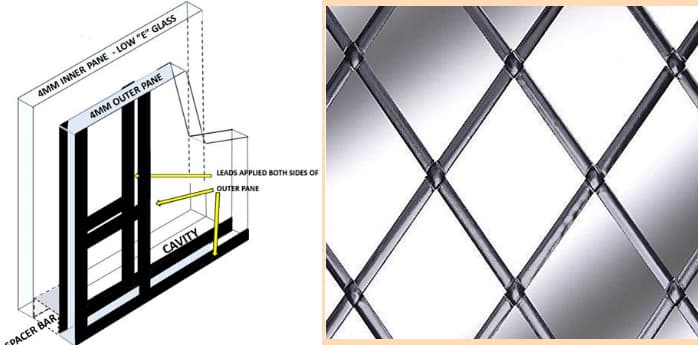

Self-cleaning glass
Self-cleaning glass sounds too good to be true… it has its place, but don’t expect miracles! This glass has a special coating on the outside of the pane that reacts with the sunshine to help break down the dirt. Then when it rains, the water is dispersed into sheets rather than droplets, and this washes the dirt away.
The most useful application for this glass is on a conservatory roof, though even there it may be necessary to hose it down from time to time. When it comes to windows and doors, it is not so effective. Self-cleaning glass needs the rain to wash the dirt away, and unless the wind is regularly blowing some heavy rain in the right direction, the dirt will not be properly washed away. The self-cleaning coating is also quite delicate, so if you do choose this option, it is worth remembering to follow the cleaning instructions if you need to clean the glass by hand once in a while.
https://www.pilkington.com/en/global/products/product-categories/self-cleaning

Imperfections in glass
The very nature of glass means there will always be some slight imperfections if you look closely enough in the right (or wrong) light. The Glass and Glazing Federation publishes some industry guidelines for visual standards detailing what is acceptable and what is not. The leaflet is called ‘Quality of vision – double glazing’ and can be found in the Downloads section of the GGF website.
https://www.ggf.org.uk/revised-datasheet-for-igu-visual-quality/
Crown glass/Restoration glass
Modern production techniques have meant that glass looks a lot flatter than it used to when it was made for windows in the Victorian and Georgian eras and earlier. The first transparent window glass was formed on a blow pipe.
A gob of glass was blown into a sphere, which was cut at the end to create an opening. The sphere was then reheated to keep the glass softened, and spun so that the sphere would stretch out and flatten to make a crown or disc. This would create a slightly distorted but clear pane of glass. The distortion was mostly because the middle of the pane was thicker than the edges which had been stretched out
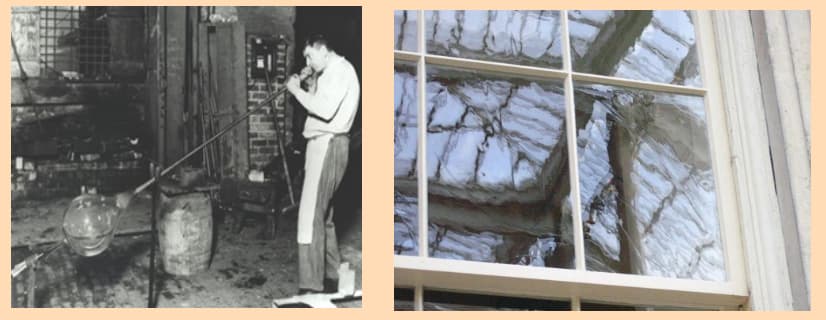
This method also resulted in a bullion being formed in the centre of the disc where the pipe had been attached. Although these bullions created a warped, distorted view they are still created to satisfy a fashion in domestic glazing. Examples of these bullions can still be see in pub windows.
When the Pilkington company first started production, it was named ‘St. Helens Crown Glass Company’ after this process which it used to produce glass
Slim Double glazing
This type of slim double glazing is often the compromise solution for heritage and listed buildings where replacement of windows is required. The conservation officer on the project wants to maintain the character of the building by minimising the double reflection from the glass and the client wants to minimise the ongoing energy and maintenance costs.
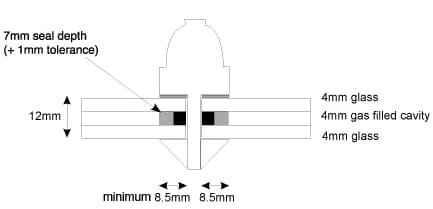
Gas infills for double glazed units
An inert gas is able to remain in its original form when under certain conditions and will not undergo a chemical reaction. This makes it ideal for use in windows, where the temperature conditions can fluctuate fairly frequently. Inert gases are commonly used nowadays, in order to help glaziers comply with the Building Regulations that were introduced in April 2002. The regulations state that all replacement glazing must meet thermal performance standards to help the homeowner lower their energy costs and reduce their CO2 output.
The most common inert gases used in double glazed units
• Argon: This colourless and odourless chemical is the most commonly used gas in windows, due to the fact that it is relatively cheap and denser than air.
• Xenon: This gas is the densest of them all, and highly insulating. It is also more expensive than argon and air, meaning it is rarely used in domestic windows.
• Krypton: This gas is denser than argon and air, but not as dense as xenon. It is an expensive option and is arguably best used in smaller cavities where convection doesn’t occur so readily.
U-Value calculations with chart
Thermal performance is judged by the heat loss through a substance – in our industry this is the glass and window frame as a combined product. This heat loss which is the thermal conductivity of the glass and window products, is known as the U-value. It is expressed: W/m2.K.
This is explained as: Watts – the amount of energy conducted per (/) metre squared – the area of the substance (.) multiplied by the temperature difference on either side of the substance being measured in Kelvin (Kelvin is the same structure as Celsius). E.g. The U-value figure 1.2 W/m2.K, means the amount of energy (1.2W) that will pass through 1m2 area of a substance for each degree of temperature difference from one side to the other. In our case heat passing through sealed units/windows.
Centre pane U-values. This is the measurement of energy conductivity through the middle of a pane of glass whether it is single glazed, double glazed or triple glazed, etc. It does not take into account anything at the edge of the glass such as the spacer bar or window frame.
Window U-values. This is the measurement of energy conductivity through the window that is made up of glazing and frame. Here spacer bar plays an important role, as may sealant. This is why window U-values are improved using warm edge spacer bar but centre pane U-values are not.
The higher the U-value of glazing or windows, then the higher the energy conductivity through them. This means that lower U-values mean better performance in terms of insulation. This is why our customers often want lower U-values as they are proof of better performing products.
Simple U-value calculation A window measures 1.2m x 1.2m = 1.44 m2, the U-value is 1.6W/m2.K – a typical ‘C’ rated window. This window will conduct 1.6 W of energy per m2 for every degree (K) difference in temperature from one side to the other. So, if it is the depths of winter and say 20 ºC inside and -1ºC outside, this is a 21ºC difference. This window will have conductivity rate of 1.6 (U-value of window) x the 1.44 m2 area of window x 21 (difference in temperature)
= (1.6 x 1.44) x 21 = 48W of potential energy loss The same size window with a U-value of 1.4W/m2.K – a typical ‘A’ rated window would work out:
= (1.4 x 1.44) x 21 = 42W of potential energy loss The same window with a U-value of 2.0W/m2.K – typical old windows with hard coat sealed units
= (2.0 x 1.44) x 21 = 60.48W of potential energy loss. Thus: the lower the U-value the lower the energy loss.
